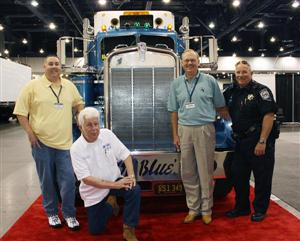Ask The Law™ - August 2009
Questions about Roadside Inspections,
Logbooks and More Answered by law
Enforcement Officials (as of Aug. 2009)
Warning: Laws are subject to change without notice.
These interpretations were made on July 10, 2009
Brought to you as a public service by Olí Blue, USA and 10-4.
Submit your questions to
www.askthelaw.org
SOME TRUCK SHOW UPDATES
We would like to thank everyone who came by to talk to us and ask questions at the Great West Truck Show in Las Vegas, Nevada. With officers from Nevada and Texas on-hand (from left to right in photo here taken by Daniel Linss, Lt. Monty Kea, RJ Taylor, Trp. Monty Dial (Retired) and Trp. Elmer Johnson), we were able to answer many questions and have a great time. Our next stop is GATS (the Great American Trucking Show) in Dallas, Texas. ‘Ol’ Blue’™ and our Ask The Law™ team will be in our Safety Center™, along with troopers from the Texas Highway Patrol, to help drivers and fleets understand various pertinent laws at GATS, held August 20-22. You can visit www.safetytour.org to find out more about this and other Ol’ Blue, USA events.
USING SPLIT SLEEPER BERTH RULE
Q: When I split my sleeper berth time, does the first part of the split have to be 8 hours or can it be 2 hours? Thanks – Mark in Ohio
A: Provided by Senior Trooper Monty Dial (Ret.), Texas Highway Patrol, Commercial Vehicle Enforcement Division, Garland, Texas: This has long been debated that because the example shown in the DOT Regulations Part 395.1 shows the 8 hour break first, followed by the 2 hour break, that that is the only way you can use the split sleeper berth provision. There is no truth to that. It doesn’t matter which comes first, as long as you have a sleeper berth break that is at least 8 hours and no more than 10 hours, and another break that is at least 2 hours but less than 10 hours either in the sleeper berth, off duty, or a combination of sleeper berth and off duty. Just remember that the shorter break is going to count against your 14 total duty hours while the 8 hour sleeper berth break stops your 14 total duty hours. Also remember that the driving hours on each side of either break cannot exceed 11 hours total before stopping and taking the next break. The only way to re-establish a full 11 hours driving or 14 hours total duty time is immediately following a complete 10-hour break. To see our new logbook presentation online, log onto www.cdlsafety.org and then click on the “2009 Hours of Service Flash Slideshow from Ol’ Blue, USA”.
CMV ROADSIDE INSPECTIONS
Q: Can a DOT Officer or any other law enforcement official just pull you over to inspect you, or do they need to have probable cause? Thank you for your time – C.E. in Louisiana
A: Provided by Senior Trooper Monty Dial (Ret.), Texas Highway Patrol, Commercial Vehicle Enforcement Division, Garland, Texas: Any DOT Officer/Inspector can stop a CMV at any time to see if the driver and/or vehicle are in compliance with the DOT Regulations (Parts 383, 390-397). They do not need any probable cause.
ADDRESS REQUIREMENTS ON LOGS
Q: One of our terminals in California recently went through a BIT inspection and we received the following citation: 13CCR 1213(e)(7) Driver Record of Duty Status is incomplete – record does not include the main office address. Our company’s logs are all pre-printed with only the city and state as the main office address. In the past 15 years of doing business we have never had a driver cited or has our company been cited during past audits (federal and CA) for not having the full address on the logs. Is the full address now required on logs? Thanks – Jim in Nevada
A: Provided by Officer James Portilla, California Highway Patrol, Commercial Vehicle Section, Sacramento, California: A city and state only would not be sufficient for a main office address. Title 49 Code of Federal Regulations Part 395.8 and California’s Title 13 are the same when it comes to required entries on a log page. 49 CFR Part 394.8 specifically states “Main Office Address” as a required entry. Black’s Law Dictionary defines address as “a place where mail or other communication will reach a person.” The rule does allow for a city and state only entry when a driver is documenting his location when making a duty status change.
~ The Ask The Law™ programs are an ongoing educational effort between Ol’ Blue, USA™ and commercial law enforcement agencies. Founded in 1986, Ol’ Blue, USA is a non-profit organization dedicated to highway safety education and to improving relations between the motoring public, law enforcement and commercial drivers. “Ask The Law” is a registered trademark of Ol’ Blue, USA. This column is copyrighted by Ol’ Blue, USA. Warning: Laws are subject to change without notice. These interpretations were made on 7/10/09 .
